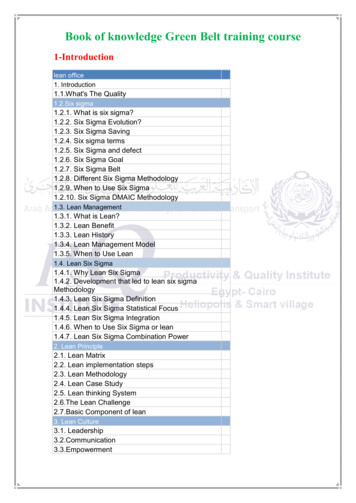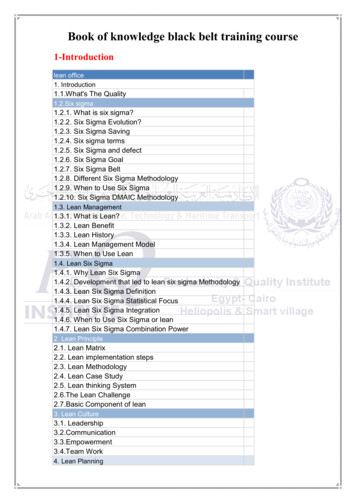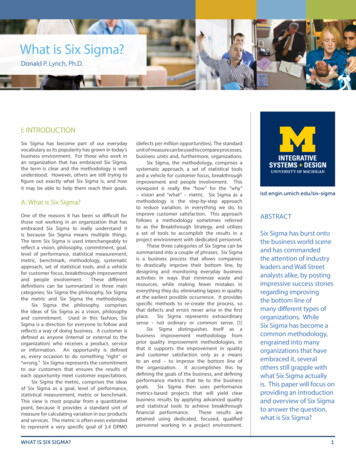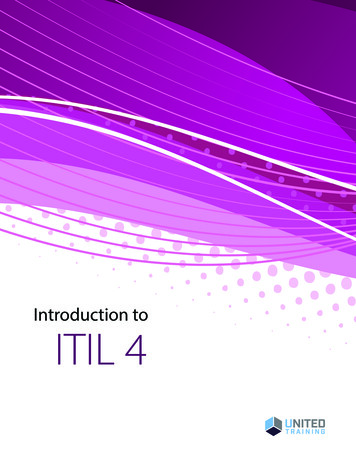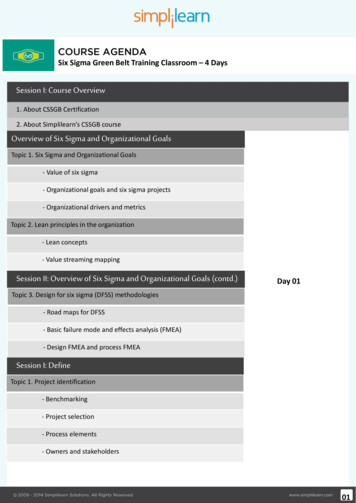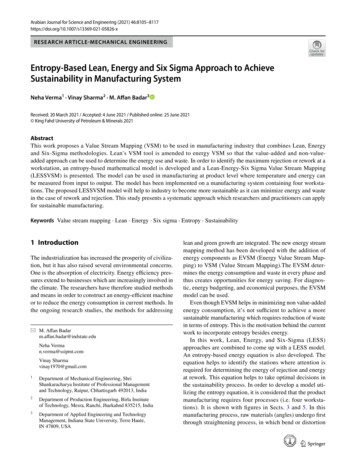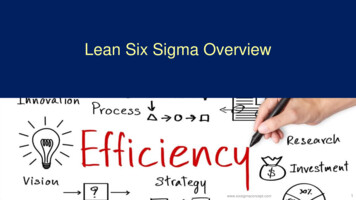
Transcription
Integrating Six Sigma and ITIL forContinual Service ImprovementJack Probst and Gary Case, Pink ElephantWhite PaperJuly 2009
Contents1Executive Summary32Service Management and the need for improvement43Overview Of Six Sigma74Application of Six Sigma to ITIL concepts115Integrating Six Sigma and ITIL to Achieve Continual Service Improvement146Aligning Six Sigma to IT Service Management197Tips, Tricks and Traps218Conclusion229About the authors23
Integrating Six Sigma and ITIL for Continual Service Improvement31 Executive SummaryThe introduction of formal ITIL processes into an organizationcan be, and normally is, a very time-consuming, expensiveand sometimes organizationally exhausting task. Manyorganizations, upon completing their process implementationprojects, breathe a sigh of relief and presume that the processeswill go on forever. Sadly, that is not the case – without continualattention to the processes they almost surely will not stayabreast of the changing needs of the organization and processperformance shortfalls will not be addressed.To address this practical and operational issue, the currentversion of the ITIL framework defines a service lifecycle stage– Continual Service Improvement (CSI) – intended to measureand improve processes and services. Through CSI process andservice owners will remain focused on poor performance andare prompted to take timely remedial action to address theseissues and challenges. Although the ITIL publication ContinualService Improvement offers a generic improvement approach,the quality practitioner may need a bit more guidance than the7-Step Improvement Process. Fortunately, multiple frameworksare available in the public domain to integrate well definedquality practices into an improvement schema.This paper discusses an approach using one such well-establishedprocess improvement methodology – Six Sigma. The SixSigma methodology is particularly compatible with ITIL. Abasic premise of Six Sigma is a focus on improvement effortssurrounding process, product or service performance thatimpacts the ultimate customer. This relationship is very similarto the relationship of services to the business and how thoseservices are managed via the ITIL processes.In this paper we review some basic ITIL principles, discuss howthose principles apply to Six Sigma, and how Six Sigma canpractically be applied to Continual Service Improvement efforts.Finally, we offer some practical tips for applying Six Sigma toimprove ITIL processes and services in general.This paper will be useful to all ITIL practitioners, process ownersand managers. It will be of particular interest to CSI managers,reporting analysts, process improvement program managers,problem managers, service level managers, service ownersand directors.As we will explore throughout the paper, Six Sigma can havebroad applicability to support the ITIL processes. As an example,the authors have worked with an organization which employedthe Design for Six Sigma (DMADV) method to help in designingand implementing their ITIL processes. For this organization, acritical component of the process design was an assurance thatthe processes would function at a high level of quality whenimplemented. We have also observed organizations using theDMAC approach when designing metrics to support ProblemManagement or their Continual Improvement initiatves.
4Integrating Six Sigma and ITIL for Continual Service Improvement2 Service Management and theneed for improvementOne of the key improvements to ITIL version 3 (V3) is theaddition of the Continual Service Improvement (CSI) practice.IT organizations have been making service improvements formany years, but they have often been in a reactive mode. Inmany cases, the improvement effort has used cost reduction(rather than improving service value) as the driver for theinitiative. For instance, when there is a failure, typically a projectis formed to address the failure – after the fact. CSI is a formalproactive practice that addresses improvement opportunitiesfor IT services, Service Management processes and the servicelifecycle. The proactive nature of CSI is one of anticipatingservice related issues and addressing them before they becomean issue for the customer. Additionally, CSI can identify areas forincreased service or process efficiency and effectiveness, whichincrease the value to the customer and/or reduce the cost ofdelivering the service.There are multiple quality frameworks available to supportimprovement activities. In this paper we discuss the relationshipof IT Service Management (ITSM) – in particular, CSI as apractice within ITIL – with a well-understood quality improvementapproach known as Six Sigma. The basis for this discussion isthe relationship of the continuity of the service lifecycle and theinteraction of improvement activities as the lifecycle is completedand started again.To set the stage for our discussion, let us review some key ITSMprinciples that will apply directly to the relationship betweenITSM, ITIL and Six Sigma.As Figure 2.1 illustrates, CSI focuses on improving the abilityof the service organization to create and maintain value forcustomers through improvements in the design, introductionFigure 2.1 Service Portfolio spine Crown copyright 2007. Reproduced under licence from OGC. Figure 2.5 Service Portfolio Spine – CSI Book – Section 2.4.8
Integrating Six Sigma and ITIL for Continual Service Improvement5and operation of IT services. The CSI practice ensures that IT iscontinually capable of enabling business outcomes even as thedynamics of the business environment change.A valuable approach to a continual review is detailed in one ofthe key CSI models: the six-step Continual Service Improvementmodel shown in Figure 2.2.One of the key drivers for process initiatives is the need toimprove the service capability of the organization; but, asmost service and process practitioners have come to realize,achieving the benefits from a service comes not just from theintroduction of the service, but in continually revisiting theservice, its performance and most importantly, the ability of thepractitioners to manage service delivery.The six steps of the Continual Service Improvement model areas follows:It would be highly unlikely for an implemented process toachieve optimal performance straight away. For that reason, inconjunction with the initial implementation of a process, wemust also introduce the organizational ability to monitor aprocess or service against established expectations; to evaluateperformance variances; and to take corrective action as neededto meet performance goals or to improve performance overtime. In addition, services, and the processes that support them,must be reviewed continually to ensure the greatest balanceof efficiency and effectiveness in order to support the businessstrategies, goals and objectives.1 – What is the vision? – Improvement opportunities arevalidated in comparison to the business and IT vision, strategies,goals and objectives.2 – Where are we now? – In order to be able to track andmeasure improvement, it is important to create an initialbaseline of how services are currently being delivered and howeffective and efficient Service Management processes are, aswell as the effectiveness of the service lifecycle itself.3 – Where do we want to be? – Defining targets for servicessuch as availability and reliability, and key performanceindicators (KPIs) for Service Management processes, providesa means for a service organization to track progress from thebaseline to the defined targets.4 – How do we get there? – The difference between wherewe want to be and where we are today is a performance gapthat should be addressed through a dedicated effort such as aFigure 2.2 Continual Service Improvement Model Crown copyright 2007. Reproduced under licence from OGC. Figure 2.3 Continual Service Improvement Model – CSI book – Section 2.4.4
6Integrating Six Sigma and ITIL for Continual Service Improvementproject. The gap is closed through the work of an improvementproject team that is managing work on a core set of deliverablesto produce the expected results.a service can be discussed and measured through the utility(what the customer wants) and warranty (how the customerwants it delivered) of the service itself.5 – Did we get there? – To measure whether the gap is closedrequires ongoing validation measurements and assessment.Were the desired outcomes achieved?Another important point is the concept of the Service Portfolioand the vital investment decisions, design and developmentactivities that must be made as part of the Service Pipeline (seeFigure 2.3).6 – Keeping the momentum going – Ensuring that changesare embedded in the organization.An underpinning concept that lies at the heart of the ITILprocess framework and the lifecycle is the definition of a service.A service is the logical representation of what a service provider– in this case, IT – assembles or produces to deliver value to acustomer (the business) through support or achievement ofcustomer outcomes. The value that the customer receives fromThe Service Portfolio identifies what is in the service pipeline; forexample, new services to be provided to the business, the publishedservice catalogue that lists all the current services available tothe business, and retired services. The value of a ServicePortfolio strategy is demonstrated through the ability to anticipatechange while maintaining traceability to strategy and planning.Details of applying the Service Portfolio in Six Sigma will bediscussed in Section 4.Figure 2.3 Service Pipeline and Service Catalogue Crown copyright 2007. Reproduced under licence from OGC. Figure 4.11 Service Pipeline and Service Catalogue, Service Strategy, Section 4.2.3
Integrating Six Sigma and ITIL for Continual Service Improvement73 Overview Of Six SigmaQuality is one of the four measurable and reportable processattributes of the ITIL Continual Service Improvement publication.As defined by CSI, quality is ‘the ability of a process or Serviceto provide the intended value’. By extension, the concept ofprocess or service quality requires meeting value expectations byinstituting an ability to monitor the efficiency and effectivenessof the process or service and to improve it, if needed.The primary differentiator between Six Sigma and other qualityinitiatives is that Six Sigma improvement efforts are based onthe ‘Voice of the Customer’ (VOC). This concept provides alens through which a quality initiative can be directed. Qualityimprovement efforts address those quality issues, and onlythose issues, that impact the customer. And it is the VOC thatcreates a linkage between Six Sigma and ITIL.Over the last 50 years, there have been numerous qualityapproaches that have focused on the improvement of processes(which can be extended to include services as well). Thelitany of process improvement concepts includes Total QualityManagement, quality control and zero defects to name a few.Many of these concepts have been espoused by leaders in thequality movement such as Shewhart, Deming, Ishikawa, andJuran, to name but a few; however, it could be argued that thebasis for these efforts has been quality for quality’s sake. Inother words, the quality improvement goal was to root out allsources of error and eliminate them irrespective of their impacton customer needs or expectations. Six Sigma is a qualitymethod that has a different focus.To expand on this further, VOC is the process of gatheringcustomer comments regarding a process, product, etc., usuallyin the form of surveys. VOC statements are translated intoquantitative specifications for the process. Those specificationsdetermine what will be Critical to Quality (CTQ), such that thecustomer believes that the process, product, service, etc. ismeeting his or her quality expectations.Six Sigma is a quality technique developed and introduced byBill Smith at Motorola in 1986 to identify and eliminate defectsin manufacturing processes. Over time, the technique has beenextended to also focus on business processes.Since the introduction of Six Sigma at Motorola, and thecompany winning the Malcolm Baldrige award two yearslater, Six Sigma has gained a global following. The list oforganizations that have embraced the practice includes GeneralElectric, Honeywell, 3M, Air Canada, Caterpillar, Dell, EMC,Lockheed Martin, DHL, Samsung Group, Siemens AG, StarwoodHotels, TRW, McGraw-Hill Companies, the arms of the USmilitary and numerous others. Six Sigma is attractive to globalorganizations requiring that parts or assemblies manufacturedin one part of the world align seamlessly with others craftedelsewhere. Variance of performance, especially in themanufacturing world, is not an option.Six Sigma and its application to business processes rely on thefact that processes can be measured, analyzed, controlled andimproved. The concept of metrics and measurement is vital. TheSix Sigma analytic techniques are statistically based and somemathematical acumen is needed to make sense of and applythem. Other quality approaches have also applied statisticalanalysis, but the key distinguishing characteristic is the focus ofthe analysis.For example, VOC customer comments might state thatan online banking website is taking too long to load andcustomers are complaining that they can’t conduct virtualbanking. The CTQ specification might be that the web pagesmust load within two seconds of a customer request. The bankIT department would then monitor the number of times theweb pages exceed a two-second load time – these are qualitydefects that could form the basis for a Six Sigma project.So, what is Six Sigma? Six Sigma is a methodology to identify,reduce and potentially eliminate process variances or poorperformance that create errors impacting the customer. SixSigma uses a variety of statistical techniques to identify theproblems and sources of error, and ultimately to design asolution that will eliminate the errors.It is the statistical underpinning that gives Six Sigma its name.Simply put, a sigma, or one standard deviation, is a statisticalmeasure of the dispersion of the values, in a set of data, fromthe average of the data. If the variation is small, the standarddeviation is small and vice versa.Although we would hope that a service would perform asdesigned each and every time it is executed, that will not be thecase, as human or other factors come into play. In many cases,those factors are the result of errors or challenges in the serviceor a process supporting the service that must be addressed.The goal of Six Sigma is to reduce the number of processdefects or errors (whether manufacturing or business). A defectis a customer experience with the process, service or productthat is outside of the customer expectations or requirements.Six Sigma endeavours to reduce the number of defects to belowa target level by measuring the performance of the process, etc.
8Integrating Six Sigma and ITIL for Continual Service ImprovementThe variability of a process, service or product can producedefects. A valuable quality calculation is to determine the yieldof the process or the number of times the process performanceis free of defects. If we perform the process 20 times and thereare five errors, the yield would be 75% (20 performances – 5errors/20 performances 100%).We now have a way to calculate the sigma level of a processor service. The accepted way to report the number of ‘sigmas’of performance is based on the number of defects per millionopportunities (DPMO) – the number of chances to have adefect. To state it differently, the DPMO represents all of theservice, process or product non-conforming (outside of theexpected performance limits) occurrences. If we want to seta performance at a Six Sigma level that would mean that theprocess or service will incur no more than 3.4 DPMO.Table 3.1 converts yield to sigma level and the correspondingsigma levels. As you can see, improving the yield (or thepercentage of times the process is defect-free) increases thesigma level. For instance, a 99.4% yield equates to 6,210defects, which is a 4.0 sigma level. While a 99.4% yield on theprocess might look great, the 4.0 sigma level still leaves roomfor substantial improvement.DMAIC is used to improve existing processes. In other words,after a process has been implemented, the DMAIC practice canbe applied to focus on a specific problem, identify the sourcesof error, and eliminate them. DMAIC stands for: 8004.099.4%6,2105.099.98%3206.099.9997%3.4Let us translate this statistical concept into some practicalresults. A process or product performing at 1 sigma wouldgenerate 690,000 DPMO or a yield of 30.9%. In IT terms, thiswould mean that for every 1,000 calls to the service desk therewould be 690 incorrectly completed incident tickets or errors– not a stellar result. If we improve to 3 sigma, the number ofservice desk errors would fall to 66.8. Finally, a 6 sigma level ofperformance would result in .0034 errors for every 1,000 calls –a laudable target.To recap this important concept, Six Sigma strives to reducethe number of process or service defects. As the process orservice is improved to eliminate defects, the yield and the sigmalevel both increase. A process improvement team can establishimprovement goals based on sigma level or yield and meetthose targets using Six Sigma methodologies.Six Sigma uses two forms of sub-methodologies to improveprocess quality. They are known by the acronyms DMAICand DMADV.Measure – Collect the relevant CTQ data from the processAnalyze – Apply analytical techniques to identify (prioritize)the root cause of the defectsImprove – Determine and implement solutionsControl – Continuously monitor the improved process.DMADV is also known as the practice of Design for Six Sigma(DSS). DSS operates under the principle that a process, productor service can be designed with quality in mind. The DMADVpractice is engaged in the following phases: Define – Identify customer-focused design goals andrequirements Measure – Identify and create measurements of CTQ factorsthat will impact the ultimate process or service delivery,possibly through the use of Critical Success Factors (CSFs) –customer needs, process capabilities Analyze – Develop the design options and design capabilitiessuch that the implemented process, service or product willachieve the design requirements Design – Develop and optimize the service process to meetthe customer requirements Verify – Test/pilot the process and transition to customer andtest that the implemented process meets the targetperformance or customer specifications.Table 3.1 Converting Sigma Level to Expected Defects per MillionSigma LevelDefine – Apply Six Sigma to a specific customer-impactingproblem that will be solved via a Six Sigma project through aset of improvement or performance requirements to achievean established goalWith the risk of oversimplifying these sophisticated practices, itis important to understand the differences between the two aswell as how they might fit within organizational practices.DMAIC can be thought of as a reactive practice. In other words,DMAIC uses or ‘reacts to’ the performance data of existingprocesses or services to target areas of concern and correctthem. DMADV, on the other hand, is more proactive in nature.DMADV supports the development of a new and well-designedprocess that should perform far better from the outset as aresult of the analytically based design process.One additional point: to be successful, both practices mustaugment or be augmented by existing organizational processesand practices in order for Six Sigma to be effective. For example,DMAIC would be an excellent fit with Problem Management orCSI to focus on any process, service or lifecycle phase activity.On the other hand, DMADV would rely heavily on the processesdetailed in the Service Design and Service Transition lifecycle stages.Several elemental roles are necessary for a successful Six Sigmaimplementation.
Integrating Six Sigma and ITIL for Continual Service ImprovementThe first are the various Six Sigma practitioners. The practitionersare designated by titles that reflect their experience in thepractice of Six Sigma and the successful completion of SixSigma initiatives. Every organization has its own methodologyand criteria for designating and appointing the various levels. Master Black Belts – These are individuals in anorganization who are the advocates of the Six Sigma practiceand who serve as coaches and mentors to other Six Sigmapractitioners. Typically, the Master Black Belts will have anumber of Six Sigma initiatives under their supervision andwill also serve to certify aspiring Black Belts. They also workto assure that the Six Sigma practice within the organizationis uniformly followed and that the required disciplines aremaintained.Black Belts – Black Belts are assigned to individual SixSigma projects and spend 100% of their time on the projectto achieve the expected quality improvements. To achieveBlack Belt certification, candidates must demonstrateproficiency in using the methodology by completing one ormore projects. Black Belts typically work under thesupervision of Master Black Belts. Green Belts – Individuals in an organization who will workunder the direction of a Black Belt on a Six Sigma project ormay lead a Six Sigma project. Typically, Green Belts are notdedicated full-time to improvement activities and have notyet reached the level of expertise and proficiency required tobe certified as a Black Belt. Yellow Belts – Some organizations also designate YellowBelts. Yellow Belts do not have the breadth of knowledge ofthe Six Sigma practices as do Black and Green Belts. Instead,these individuals may be assigned to perform very targetedtasks in support of a Six Sigma project, or may lead improvementinitiatives using the Deming Plan-Do-Check-Act (PDCA)methodology.Two other organizational roles are vital to success of Six Sigma.They are: Executive leadership or sponsorship – One of the CSFsfor a Six Sigma initiative is the support of senior management.Six Sigma, as an organizational discipline, will require asubstantial investment of time and resources to be successful.For instance, Six Sigma practitioners will require time tocomplete extensive training, and Six Sigma projects aretypically substantial in terms of cost. This level of organizationalinvestment requires senior leadership to allocate scarceresources. Black Belts may shift permanently to this qualityrole from other important functions to clear organizationalobstacles and road blocks and provide critical oversight of SixSigma initiatives to ensure that expected returns are achieved.Champions – Six Sigma requires a champion especially asthe discipline will potentially change the modus operandi ofthe firm. The Champion will be called upon to be thespokesperson, advocate or the outward face of the Six Sigmapractice. The Champion must be willing to go anywhere totalk to anyone, at anytime, about Six Sigma, the benefits and9the reality of quality initiatives under the wing of Six Sigma.The Champion may be a unique role within an organization,or undertaken by the Master Black Belt.How does a typical Six Sigma project work? Figure 3.1, on thenext page, outlines some of the major activities of a typical SixSigma initiative.The initial step in Six Sigma is the identification of the problemto be solved. One might say that the problem is a source ofcustomer dissatisfaction, such as having recurring incidents dueto a service being up and down. Another way to think aboutthe starting point as an initiative that must be undertaken tomove the organization forward. Whether solving a problem ormoving along with a new project, there must be a clear reasonfor engaging Six Sigma and the valuable resources required forsuch a project.Next is the need for executive support. This support may takethe form of a sponsoring authority or the funding source. Seniorlevel engagement is necessary as Six Sigma initiatives are notsmall undertakings.What follows next is a focus on the scope of the Six Sigmaeffort. What part of the business or customer arena will be thetarget of investigation? Will the initiative be limited to onecustomer segment or is the intention to look broadly across allmarkets the organization serves? The key is that the scope ofthe initiative is aligned with a challenge that the customer– whether the ultimate customer of the business or an internalcustomer of IT, such as the financial group – believes improvementwould serve their interests directly. In other words, theimprovements can be clearly articulated in customer terms –both the initiative to secure the improvement as well as theend results.At this point, the project is initiated, a project charter completedand appropriate funding has been allocated. Make no mistake:Six Sigma initiatives are projects and as such should begoverned that way. Project management brings the necessarydiscipline to the forefront to ensure that resources are engagedappropriately, at the right time and that there is formaloversight of the improvement effort, possibly via a projectsteering committee. The project scope is, of course, stated interms and will be targeted to improve aspects of an existingproduct, process or service, or possibly to introduce a newproduct, process or service. The bottom line is that a Six Sigmaeffort is formal and focused.The Six Sigma discipline now moves into high gear, collectingand analyzing data and applying the Six Sigma practicedisciplines. For simplicity’s sake, the project illustrated in Figure3.1 suggests this is a DMAIC effort, but this project could easilyengage DMADV. However, whether we are speaking of DMAICor DMADV, the project goal and its objectives are to improvethe area within a customer-oriented scope; the results aretangible, measurable and will be reported.
10Integrating Six Sigma and ITIL for Continual Service ImprovementFigure 3.1 Activities of a typical Six Sigma initiativeAs Service Management and the ITIL framework are nowconsidered a lifecycle, so are improvement efforts. Thus, as oneSix Sigma project is implemented and the benefits are realized,the operating business dynamic changes as well. These changesfoster new opportunities for the next Six Sigma effort as thebusiness climate changes, customer expectations evolve or anyof the other myriad of business dynamics drives the need tolook inward one more time to bring improvement to products,processes or services.
Integrating Six Sigma and ITIL for Continual Service Improvement114 Application of Six Sigma to ITIL conceptsWith a basic explanation now presented of Six Sigma and howit works, both mechanically and organizationally, a pressingquestion remains: how does Six Sigma apply to ServiceManagement? Answering this question requires an evaluationof ITIL principles and how Six Sigma, as an improvementmethodology, would provide value as a tool of the CSIpractice. In addition, as Six Sigma relies extensively on processmeasurements, there must be agreed to and documentedService Management metrics and measurements that areaccurate and consistently reported on. Let us take a look atsome basic ITIL concepts developed as part of ITIL V3 and findsome common ground to answer this question.A basic premise of what sets Six Sigma apart from other qualityefforts is the concept that all improvements are focused on theVoice of the Customer (VOC). In other words, Six Sigma doesnot undertake improvements for their own sake, but with theexpressed intention of improving the customer experience –more specifically, improving the customer’s interaction with theorganizational products, services or processes consumed for thebenefit of the customer.So, the question is: is there a VOC concept within ITIL and if so,how would it apply?The VOC can be considered at two levels. At the lower level, weshould consider how the process or service, and the defectsaddressed by Six Sigma, are those that directly impact a firm’scustomers. Those defects could affect an organization’sreputation or customer goodwill – thus the need to be veryfocused on customer-facing issues. At the higher level, wemight also consider those issues that could impact the businessstrategy, objectives and goals. Clearly one could make theargument that the accumulation of customer-based issues willeventually impact business goals or objectives. In the end, thebusiness is the customer of IT or the service provider. Thereforeany issues, caused by the service provider, impacting thebusiness would be within the scope of a Six Sigma investigation.An important definitional note is needed here. As explained inthe context of the VOC in Section 3, the concept of the customeris integral to the Six Sigma methodology and practice. In SixSigma language, a customer is ‘a person who receives theproduct or service of a process’.1 However, in the ITIL languagethe term ‘customer’ defines ‘someone who buys goods orservices’2 or the individual who has the chequebook. Thisindividual may or may not be a user. ITIL defines ‘user’ as ‘aperson who uses the IT Service on a day-to-day basis’3 oressentially the individual who relies daily on the product orservice to support his or her daily activities.For purposes of our discussions, we will use the term ‘customer’.A customer is an individual or entity who consumes a serviceor a product that the ITIL processes support, and who hasexpectations or expected standards of performance relativeto the service or product. It is when those expectations orstandards of performance are not met that the VOC comesto the fore.At the heart of understanding how Six Sigma applies to ServiceManagement is the concept of a service. One of the mostimportant and fundamental improvements in the recent ITI
- Continual Service Improvement (CSI) - intended to measure and improve processes and services. Through CSI process and service owners will remain focused on poor performance and are prompted to take timely remedial action to address these issues and challenges. Although the ITIL publication Continual Service Improvement offers a generic .

